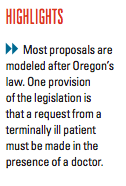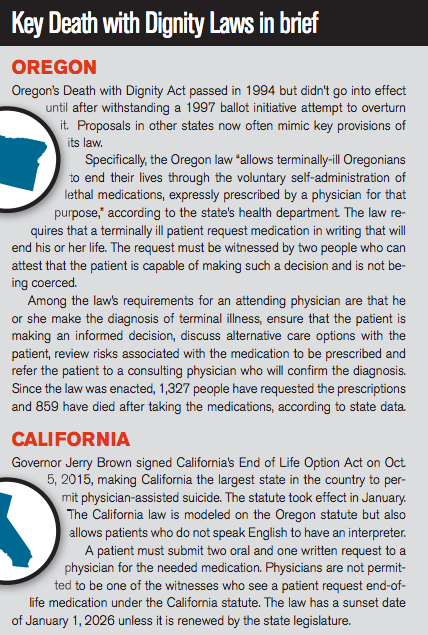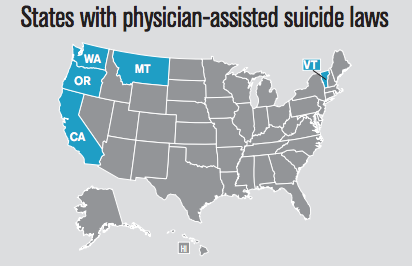Article
Physician-assisted suicide up for debate
Author(s):
What role should physicians have in states where assisted suicide is allowed?

The battle over passing what proponents call end-of-life bills and what opponents call physician-assisted suicide legislation already has surfaced in New York, Colorado and Maryland this year. Expect roughly 20 other states to consider similar legislation before the year is out.
The differences in language used by the two sides demonstrate how sharp the ideological divisions are and how fierce the lobbying is likely to be for and against these measures.
Enactment of these laws protects physicians from liability if they prescribe end-of-life medications for terminally ill patients who request them and after the patients have complied with the requirements of the legislation. But laws currently in effect do not compel doctors to write such prescriptions if their moral or religious beliefs preclude them from doing so, say proponents. Opponents have concerns, however.
“We think it’s going to fundamentally change the doctor-patient relationship,” says David Stevens, MD, president of the Christian Medical & Dental Association, which opposes physician-assisted aid in dying. “Can you easily trust a doctor who can cure you or kill you?”
The American Medical Association’s (AMA’s) official position on the matter is to oppose what it terms physician-assisted suicide. “Allowing physicians to participate in assisted suicide would cause more harm than good. Physician-assisted suicide is fundamentally incompatible with the physician’s role as healer, would be difficult or impossible to control, and would pose serious societal risks,” states AMA ethical opinion 2.211.
The American Academy of Family Physicians “doesn’t have a policy specifically on physician-assisted suicide,” according to a spokesperson, but follows the AMA Code of Ethics. Through its own ethics guidelines, the American College of Physicians “does not support legalization of physician-assisted suicide or euthanasia,” according to its manual.
On the state level, however, the story is different. “Almost in every state where it has been legalized, the state medical association has taken a neutral stance. Whenever that happens, it passes,” says Stevens.
That was the case in California, for example, which enacted a bill last year. Backers say California’s move means momentum is on their side in 2016.
California A harbinger?
“With the win in California last year, it only makes sense to go after the big and impactful states. That will lead to other states after them,” says Peg Sandeen, PhD, MSW, executive director of Death with Dignity, one of the groups supporting right-to-die legislation.
“Our work in California really changed the narrative,” agrees Jessica Grennan, national director of political affairs and advocacy for Compassion & Choices, which led efforts to pass the California legislation. Legislators in other states have been in touch to discuss lessons from California they can apply in their states.

The widely-reported saga of Brittany Maynard, the 29-year-old California woman who moved to Oregon so she could end her life rather than continue suffering with terminal brain cancer, helped garner the support needed to pass the California legislation. Maynard’s husband has spoken in other states in support of the end-of-life option legislation, Grennan says.
In addition to pushing measures in state legislatures, backers have used court challenges. States that have enacted so-called death with dignity statues include Oregon, California, Washington and Vermont, while the Montana Supreme Court decided the end-of-life option is legal in that state.
States to watch
States to watch this year in addition to those listed above include Minnesota, Massachusetts and Iowa, Grennan says.
The issue is likely to surface in 20 to 25 other states over the course of the year, predicts Diane Coleman, president and chief executive officer of Not Dead Yet, a group opposing right to die legislation. Congress has shown no appetite to address such a controversial issue and is even less likely to do so during an election year, both sides agree.
Some medical groups have backed end-of-life legislation. The American Medical Students Association, for example, signed on to a letter of support for the California legislation, says Deborah Vozzella Hall, MD, national president of the association.

“Medical decisions belong to patients and their care providers and this falls into that category,” says Hall. “We have really long supported the idea of autonomy for patients, understanding that there have to be appropriate measures in places to make sure that a terminally ill patient isn’t suffering from depression or external pressures.”
In Colorado, both the Denver and Boulder medical societies are supporting a proposal, says Grennan. “We’re starting to see more support across the board from physicians,” she says.
The oregon model
Most proposals are modeled on the Oregon law, which was passed in 1994 but did not go into effect until after voters had defeated a 1997 ballot initiative to repeal it. It has since withstood a variety of legislative and legal challenges.
It requires a patient diagnosed as terminally ill to “make a written request for medication for the purpose of ending his or her life in a humane and dignified manner,” according to text of the legislation. The request has to be witnessed by two people, one of whom is not related to the patient nor entitled to any portion of the patient’s estate. The request has to be made in the presence of a doctor.
The law also outlines requirements for the attending physician, including his or her diagnosis and prognosis and discussion of feasible alternatives such as hospice care. It also stipulates that a physician does not have to provide end-of-life medication, saying only that if a doctor does not want to participate he or she should transfer a patient’s records to a new provider selected by the patient.
Maryland’s proposed law also requires doctors who do not wish to participate only to transfer records, notes Shane Pedergrass, a member of the Maryland House of Delegates and a sponsor of the legislation. “We’re trying very hard to not make people who have a particular belief system not do what they want,” she says of doctors who may have moral or religious objections to aiding in end-of-life care.
Pendergrass’s bill is titled the End of Life Option Act, an attempt to defuse some of the language-related rancor associated with the issue, Pedergrass notes.
Pendergrass’s bill never made it out of committee, however, as the Maryland General Assembly ends its year. A state senate version of the bill was withdrawn as well.
Opponents do not believe the law’s safeguards for doctors or patients are sufficient to prevent abuses. They worry that patients may be coerced into requesting to end their lives by family members or doctors.
“The risks of mistakes, coercion and abuse are too great,” says Not Dead Yet’s Coleman. Such laws are “extremely dangerous public policy for old and disabled people,” she says.
Stevens echoes Coleman’s concerns. “They’re making a tragic mistake,” he says of those who back such legislation. “Once you say that suffering merits this if people want it, there’s no logical place for people to draw the line.”
Opponents also worry that insurance companies will push for end-of-life options rather than pay for prolonged care for terminally ill patients.
Proponents such as Pedergrass counter that the insurance argument is being used to divert attention from an honest discussion of whether people have the right to end their lives as they wish. “Once you see someone suffer and be completely unable to relief that suffering, you’re one bad death away from supporting this,” Pedergrass argues.





